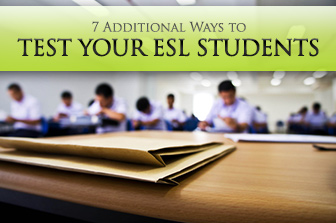7 Keys to Creating Tests that Make Students Feel Good about Themselves


Test: a set of questions, problems, or the like, used as a means of evaluating the abilities, aptitudes, skills, or performance of an individual or group; examination.
– from Dictionary.com
But they are necessary for more than the grade/score your students obtain. They are important because they are concrete proof of what your students have learned and what they need to continue working on.
I like to think of tests as a gauge, not of course as an instrument that gives you a precise measurement, but rather a tool that allows you to assess your students’ skills and to what extent they can perform in an English-speaking setting. Now, must all tests be written, multiple choice, matching or fill-in-the-blanks exercises? According to the definition above, a test is a set of questions, problems, or the like. “Or the like” includes any and all strategies and techniques that will allow you to effectively evaluate your students’ skills. Here are 7 testing strategies that fall into the “or the like” category.

Very young learners can’t write or speak as much as older students, which is why we often choose not to “test” them. Although they grasp a lot more than what they can produce verbally, there are still plenty of things they can “produce” to show you how much they’ve learned. Say they learned to talk about themselves and their family. Ask them to draw a family portrait and say as much as they can about it, even if it’s just naming the people in it.
If your students are old enough to read at least words, prepare a test with images they have to label or match. You may also have them cut out the images and the words, and then glue them in matching sets on another piece of paper. Have them label the parts of the body. Or classify animals as “wild”, “farm” or “domestic”.
Role plays are excellent for evaluating student performance at any level or age. With very young learners, I recommend using puppets or dolls. Have the children manipulate the puppets so they can greet each other and ask each other questions. They may even put on their own puppet show if they’re old enough!
There are any number of written projects students may present for assessment. You may start a project at the beginning of the school year, which they need to build on and present at the end, kind of like a road map of where they started and where they ended up. Or ask them to research something they’re interested in, like a celebrity or sport, and present a written report complete with images.
Oral presentations are my favorite way of assessing advanced adult learners for whom the basic multiple choice test is simply too easy. Have students prepare a PowerPoint presentation. You can evaluate their writing skills in the slides they prepare and their communication skills in the oral presentation. There’s no limit to what your students may choose to do as their oral presentation. Dress up as a historical figure? Or pop star?
To assess the class as a group, have them write their own play to perform. Or have pairs write their own role plays/interviews and act them out. Younger students can work together to create a diorama. The advantage of these types of assessment is that you’ll be able to evaluate not only what they produce as a final result of the collaboration, but just how well they’re able to collaborate in English (make requests, ask someone for assistance, give/ask for instructions, agree/disagree, etc…)
For a completely novel approach to testing, create your test as a PowerPoint presentation instead of a paper test you’ll print and hand out. Students can read each slide and complete the tasks assigned to them on a separate sheet of paper, from replying to an email to watching a video embedded in the slide. If you have a classroom with plenty of computers for all, they can even pace themselves, and they won’t have to wait for their classmates to finish a task before continuing to the next slide. The best advantage to this type of test is that you can include a variety of multimedia files (image, audio and video) all organized into a single testing experience.
These other ways of testing your students’ progress and performance are just as valid as any standardized test. If you create each testing experience with your students’ goals and needs in mind, you can’t go wrong.
Would you use one of these as the sole testing experience or as a complement to the typical written test? As usual, if you have any tips, ideas or comments, share them below!